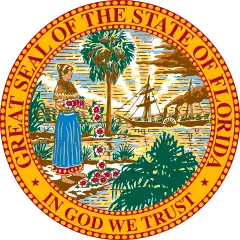Christmas, Florida
Christmas is a census-designated place and an unincorporated area in Orange County, Florida, United States. It is part of the Orlando–Kissimmee Metropolitan Statistical Area.
Christmas, Florida | |
|---|---|
 Location in Orange County and the state of Florida | |
| Coordinates: 28°32′N 81°0′W | |
| Country | |
| State | |
| County | |
| Area | |
| • Total | 3.4 sq mi (8.9 km2) |
| • Land | 3.4 sq mi (8.9 km2) |
| • Water | 0 sq mi (0 km2) |
| Elevation | 43 ft (13 m) |
| Population (2010) | |
| • Total | 1,146 |
| • Density | 330/sq mi (130/km2) |
| Time zone | UTC-5 (Eastern (EST)) |
| • Summer (DST) | UTC-4 (EDT) |
| ZIP code | 32709 |
| Area code(s) | 407, 689, 321 |
| FIPS code | 12-12250[1] |
| GNIS feature ID | 0280429[2] |
The population was 1,146 at the 2010 census.[3] Christmas is home to the world's largest alligator-shaped building, measuring at just over 200 feet (61 m); to Fort Christmas Historical Park, a recreation of the Second Seminole War Fort Christmas; and to Fort Christmas Folk School, a nonprofit school dedicated to teaching folk arts. Every year, Christmas sends a large amount of mail from its post office from people who mail letters from the town so they can have the "Christmas" postmark on their holiday mailings.[4]
Christmas is the birthplace of the American sculptor James Hughlette "Tex" Wheeler, who is best known for his bronze sculpture of the famed racehorse Seabiscuit which holds a place of honor at Santa Anita Park racetrack in California and his "tribute to the American folk humorist, Will Rogers at Claremore, Oklahoma".[5] Wheeler is buried in the Fort Christmas Cemetery.

Christmas is home to many Orlando digital TV stations' transmission towers.
History
On December 25, 1837, a force of 2,000 U.S. Army soldiers and Alabama Volunteers arrived in the area to construct a fort, which they named Fort Christmas. The fort was one of over 200 forts built during the Second Seminole War. In 1892, a Post Office opened at Christmas.[6]
Geography
Christmas is located at 28°32′N 81°0′W (28.5324, -80.9940).[7] According to the United States Census Bureau, the Christmas CDP (Census Designated Place) has a total area of 3.4 square miles (8.9 km2), all land.[8]
Popular culture
Christmas is one of the many settings in John Green's 2008 novel Paper Towns. In the book, three Orlando high school students embark on a journey to find their friend, who has recently gone missing. An old abandoned mini-mall in Christmas is one of the places where they search for her and find clues vital to her case.
Demographics
As of the census[1] of 2010, there were 1,146 people (down from 1,162 in the 2000 Census), 422 households (up from 420 in the 2000 Census), and 304 families (the same as in the 2000 Census) residing in the Christmas CDP (Census Designated Place).[9]
As of the 2000 Census, the population density was 125.7/km2 (325.3/mi²). There were 446 housing units at an average density of 48.2/km2 (124.9/mi²). The racial makeup of the Christmas CDP was 95.44% White, 0.43% African American, 0.69% Native American, 0.95% Asian, 0.60% from other races, and 1.89% from two or more races. Hispanic or Latino of any race were 2.15% of the population.
As of 2010 there were 422 households, of which 34.8% had children under the age of 18 (up from 30.5% in the 2000 census) living with them, 50.5% were married couples living together (up from 49.5% in 2000), 12.1% had a female householder with no male present (down from 14.0% in the 2000 Census), 9.5% had a male householder with no female present (data from the 2000 Census is not available) and 28% were non-families (up from 27.6% in 2000). 25.4% of the households had individuals 65 years of age or older (a dramatic increase from the 8.3% in 2000). The average household size was 2.72 (2.77 in 2000) and the average family size was 2.99 (down from 3.08 in 2000).

In the Christmas Census Designated Place (CDP), as of the 2010 Census, the median age was 41 years old (up from 37 years old in the 2000 Census). In 2010, 46.9% of the residents of the Christmas CDP were women and 53.1% were males.
The median income for a household in the Christmas CDP was not available for the 2010 Census.[10]
Panoramic view
References
- "U.S. Census website". United States Census Bureau. Retrieved 2008-01-31.
- "US Board on Geographic Names". United States Geological Survey. 2007-10-25. Retrieved 2008-01-31.
- "Profile of General Population and Housing Characteristics: 2010 Demographic Profile Data (DP-1): Christmas CDP, Florida". United States Census Bureau. Retrieved September 21, 2012.
- Clark, Alisson (May 10, 1999). "What's in a name?". Ocala Star-Banner. pp. 3C. Retrieved 7 June 2015.
- Dickinson, J. W. (2006). Remembering Orlando: Tales from Elvis to Disney. Charleston, South Carolina: The History Press.
- "United States Postal Service Postmaster Finder". United States Postal Service. 2017. Retrieved 2017-11-30.
- "US Gazetteer files: 2010, 2000, and 1990". United States Census Bureau. 2011-02-12. Retrieved 2011-04-23.
- "Geographic Identifiers: 2010 Demographic Profile Data (G001): Christmas CDP, Florida". United States Census Bureau. Retrieved September 21, 2012.
- Definition of the acronym "CDP" as used here was found on the U.S Census Bureau's website on 2 October 2012.
- All 2010 U.S. Census data provided here was quoted from the US Census Bureau's website on 2 October 2012
External links
| Wikivoyage has a travel guide for Christmas. |
| Wikimedia Commons has media related to Christmas, Florida. |


